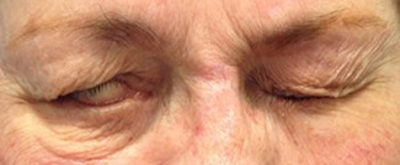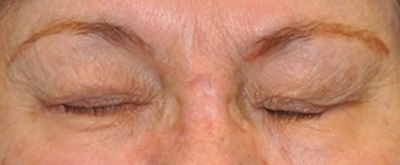Mobius Syndrome
Congenital (at birth) facial nerve paralysis can affect both sides of the face leading to severe disfigurement. Treatment is similar to our traditional techniques for facial paralysis except a different “power source” is needed to restore dynamic facial motion. Nerve grafts can be approximated to the trigeminal nerve (masseteric branch, V3) to achieve similar results.
Other
Eyelid Closure
Upper Eyelid – The facial nerve is responsible for closing the eyelid via the orbicularis oculi muscles. A different nerve maintains an open eyelid and balance is important in eyelid function. This is important for maintaining hydration to the eye itself and preventing corneal injury. Many patients naturally have whats known as the Bells Reflex where the eyeball rotates up when we sleep, which protects the cornea in the event the eyelids can not close. An exposed cornea can lead to blindness and a surgery aimed at protecting it is of paramount importance. A gold or platinum weight can be placed on the upper eyelid to help gravity assist in closing the eye when needed. This relatively simple operation can be performed as an outpatient or in the office setting.
Lower Eyelid – weakened tone of the lower eyelid muscles can lead to a droopy lower eyelid and increased exposure of the white part of the eye (sclera). Treatment is aimed at raising and tightening the lower lid so that there is less exposure of the eye. We accomplish this using midface lifting with orbital rim anchoring as well as canthoplasty techniques.


Dynamic (SMILE)
Lip and Cheek Animation – Facial expression is the key to social interaction, and the ability to smile and show emotion is what allows us to form healthy bonds. Facial paralysis can cause severe asymmetry, particularly upon smiling. Restoration of dynamic movement may require both nerve and muscle transfers.
Nerve grafts are obtained from a sensory nerve from the lower leg which can be approximated to the facial motor nerve on the unaffected side. We then can connect the newly “powered” nerve to the abnormal side and provide the electricity needed to move the previous “unpowered” muscles. Nerves regenerate at the rate of 1mm/day and several months may be required to see results.
When the muscles are without “power” for > 1 yr they often wither away and atrophy. New muscle must be placed to allow for dynamic function. The gracilis muscle from the thigh is often transferred to the face to restore the ability to smile in lieu of the dysfunctional facial muscles. This is often done 6-9 months after the initial nerve graft to allow for nerve regeneration.
Temporalis transfer for Smile Restoration
Dr. Bastidas performs a regional muscle transfer from the head to the lips to recreate the ability to smile by simply attempting to clench your jaw. This can be done without any significant impairment to function and with only a small scar located on the laugh line on the face. The results are immediate and incredible. Physical therapy is initiated even before the smile surgery to “train your brain” and allow for the best results possible. Our patients to pose for pictures with confidence after this procedure. Botox may also be injected to the opposite side to further improve symmetry.